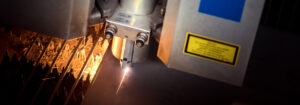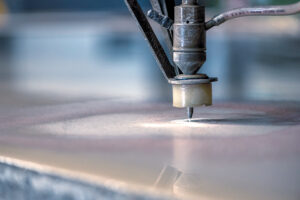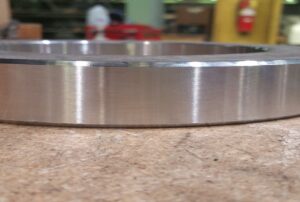Plasma cutting is a process of cutting and shaping conductive materials. It is a key process in industrial and metal fabrication. Plasma cutting works by forcing a gas, typically compressed air, through a small channel or nozzle. An electrical arc is then used to ionize the gas, forming plasma which is a high-temperature and ionized gas. This plasma is then forced through the nozzle at high speed towards the metal workpiece.
As the plasma flow comes into contact with the metal, it heats the metal up to its melting point. The molten material is then blown away with the high-velocity plasma stream. The process is repeated along the cutting path, creating a narrow kerf with the molten metal blown out of the cut. CNC plasma cutting machines use computer-controlled movement to direct the path of the plasma stream. This allows for accurate and intricate cuts.
Tolerances & capabilities
| PLASMA | ||||||
|---|---|---|---|---|---|---|
| 156″ x 500″ max size | ||||||
| THK | Standard | |||||
| .1875″ ≤ 1.50″ | +/-.0625″ | |||||
| >1.50″ ≤ 2.00″ | +/-.125″ | |||||
| >2.00″ ≤ 4.00″ | +/-.25″ | |||||
| >4.00″ ≤ 6.00″ | +/-.375″ | |||||
| Bevel | 0°-59° | |||||
| Max Thk. | 4″ | |||||
| Max Width | 120″ | |||||
| Max Length | 480″ | |||||
| Bevel Tolerance | +/- 2° | |||||
Advantages of Plasma cutting
Cost
Lower cost than waterjet, laser or saw cutting.
Shapes
Can be used to cut rings, disks and other shapes.
Speed
Quick turn around times and typically shorter lead-times.
Limitations of Plasma cutting
Heat Affected Zone
Very high temperatures create a heat affected zone around the cut surfaces. Should be removed by secondary processes.
Cut quality & Tolerances
Small holes and 3D geometry are not available with Plasma cutting. Waterjet and Laser is the alternative.
Heat Sensitive Grades
400 series and PH grades have limitations.
Contact your closest JACQUET location to find out how plasma cutting can help with your bottom line.




